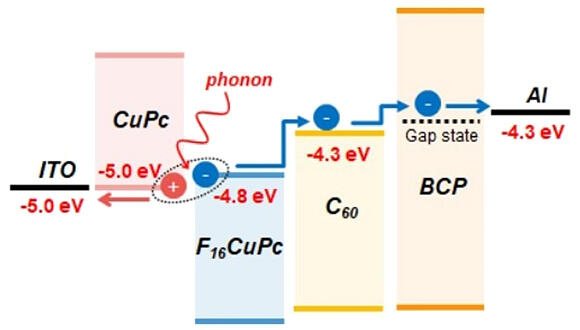The Seebeck effect is exploited in thermoelectric conversion elements that generate electricity from heat. However, their application is limited because they require a certain temperature gradient. A research group from Kyushu University, the Kyushu Institute of Systems, Information Technologies and Nanotechnologies (ISIT), National Centre for Scientific Research (CNRS), France, and GCE Institute (GCEI) successfully developed an organic thermoelectric device based on a new power-generation mechanism utilizing organic charge-transfer (CT) complexes. Because electricity can be extracted from heat near room temperature and it is theoretically possible to implement this technology in large areas, this development is expected to lead to the realization of a completely new power-generation system.
Professor Chihaya Adachi stated, "The obtained voltage was approximately 0.4 V. Although current was less than microamperes per square centimeter, if the area is large, an unlimited amount of power can be extracted. Further, it may be possible to create interesting flexible large-area devices that generate electricity in forms, such as wallpapers and clothing. Many aspects of this mechanism remain unclear, and we want to gain a precise understanding of the mechanism and continue to improve its performance." The results were published in Nature Communications.

Provided by Kyushu University
Today, there is widespread demand for the effective use of renewable and untapped energy sources globally. Although thermoelectric devices that utilize waste heat have been commercialized, their application is hindered by numerous challenges, including the use of highly toxic materials and expensive precious metals and limited installation space required to generate temperature gradients. Meanwhile, a wide range of functional devices have been developed in the field of organic electronics, including organic EL diodes (OLEDs), organic solar cells (OSCs), organic field effect transistors (OFETs), and, more recently, long-persistent luminescence (LPL) materials.
In these devices, intra and intermolecular CT phenomena occurring between donors and acceptors are crucial in the functional expression of each device, including charge injection, transport and exciton dissociation at the interface, exciton generation by charge recombination, and orientation polarization characteristics in organic thin films.
The research group also included Associate Professor Hajime Nakanotani, Graduate Student Mana Kameyama, Graduate Student Shun Kondo (currently at Sumitomo Chemical), Graduate Student Kentaro Imaoka (currently a PhD student at University of Göttingen) of the Center for Organic Photonics and Electronics Research, Group Leader Masayuki Yahiro of the ISIT, Research Director Fabrice Mathevet of CNRS, and Chief Scientist Takashi Fujihara of GCEI. They succeeded in extracting small amounts of thermal energy of the order of few tens of millielectronvolts, which exists at room temperature in everyday life, as electrical energy, by adjoining the highest occupied molecular orbital (HOMO) of the donor and the lowest unoccupied molecular orbital (LUMO) of the acceptor in CT excitons generated at the organic CT interface.
Adachi continued, "The idea is based on the concept of thermally activated delayed fluorescence (TADF) (TADF was developed by Professor Adachi and has been put to practical use in some OLED displays). In the case of TADF, exciton upconversion occurs when the energy difference between the singlet and triplet excitons is set to approximately room temperature. Hence, we thought that if the donor HOMO and acceptor LUMO are brought close together, charge separation will occur at their interface. In organic solar cells, photon energy causes charge separation at the p-n interface. Similarly, we thought that charge separation may occur if the energy of phonons (heat) is equivalent to the HOMO-LUMO difference at the p-n interface. I strongly believed that it must be possible."
The first device had two layers of CuPc and F16CuPc but did not generate a significant amount of electromotive force.
Adachi added, "We did not give up at this point, and when we layered C60 and BCP on top of F16CuPc and changed the thickness of each layer, the characteristics improved rapidly, and this was the moment when we realized this could work. The students did a great job in these experiments, and I am very grateful to them."
The thermoelectric characteristics were greatly improved by creating a multilayer structure. The optimized device yielded an open-circuit voltage of 384 mV, a short-circuit current density of 1.1 µA/cm2, and a maximum output of 94 nW/cm2. The temperature characteristics of the thermoelectric properties showed that the activation energy values are approximately 20-60 meV, confirming that low-level thermal energy at room temperature contributes to the power-generation mechanism. Furthermore, surface potential analysis using a Kelvin probe confirmed that charges are generated at the CuPc/F16CuPc interface, and that electrons and holes diffuse and migrate to the opposing electrodes by exploiting the alignment of the Fermi levels between adjacent layers.
This demonstrates that the newly developed organic thermoelectric device exhibits a new power-generation mechanism that helps extract low-level thermal energy at room temperature without temperature gradient. Based on the elucidation of the power-generation mechanism, the research group will continue to comprehensively improve the device's thermoelectric performance by optimizing the material parameters of each layer, developing new molecules, and optimizing the device structure. They also plan to continue to explore inexpensive approaches to increase the area using methods such as solution coating, which take advantage of the unique characteristics of organic materials.
Journal Information
Publication: Nature Communications
Title: Organic thermoelectric device utilizing charge transfer interface as the charge generation by harvesting thermal energy
DOI: 10.1038/s41467-024-52047-5
This article has been translated by JST with permission from The Science News Ltd. (https://sci-news.co.jp/). Unauthorized reproduction of the article and photographs is prohibited.




